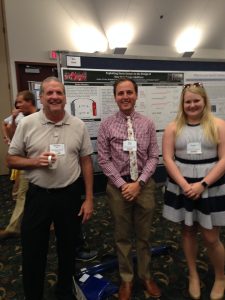Amber and Nick collaborated on a poster for presenting at the Schaap Symposium…
High Potential Organic Redox Shuttles for Overcharge Protection in Lithium Ion Batteries; Amber J. Prins, Nicholas J. Mortimer and Thomas F. Guarr*
Lithium ion batteries are universally used today, but unsafe conditions can occur if expensive electronics are not used to prevent overcharging. These electronics can double the price of the battery pack, so it is important to find a more economical way to control charging. “Redox shuttles” are potential additives to batteries to shunt the excess current and allow the battery to be safely used to its full capacity. When overcharge current flows through a battery, the redox shuttle is oxidized to form the radical cation which diffuses across the cell and is reduced at the anode. This effectively turns overcharge current into thermal energy which can be readily controlled, thereby preventing battery degradation. Numerous organic compounds have been investigated as shuttle candidates, but finding materials that possess the following qualities proves challenging: 1) high oxidation potential (generally > 4.2 V vs. Li/Li +); 2) solubility in battery electrolytes; 3) compatibility with other electrolyte components; 4) high stability in both reduced and oxidized forms (leading to long cycle life).
This project is made possible in part by a grant from the Community Foundation of the Holland/Zeeland area, as well as through financial support from a Michigan Strategic Fund grant through Lakeshore Advantage to MSU.
Tom Guarr also presented similar posters at the 68th Annual International Society of Electrochemistry in Providence, RI on August 30 and at the 232nd Electrochemical Society meeting in National Harbor, MD on October 5, 2017.
